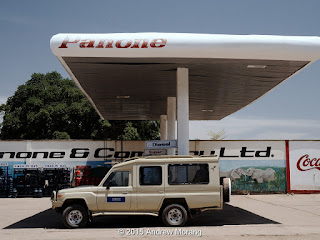 |
| Tarangire National Park, Tanzania (Panasonic G3 digital file, reprocessed with DXO Filmpack 5) |
My wife and I recently watched the Netflix nature program,
Our Planet. It features some spectacular photography from harsh environments, including animals seldom photographed (such as the Siberian Tiger). Episode 5, "From Deserts to Grasslands," described how baobab trees have incredibly deep roots that can tap water while the surface is in severe drought. I remembered being amazed by the huge baobabs in Tanzania and decided to revisit some 2015 files.
 |
| Tarangire National Park, Tanzania |
Baobab trees are found in arid parts of Madagascar, Africa, Arabia, and Australia. The trunks can be meters in diameter and contain a large amount of water. In drought, elephants chew on the trunks to extract moisture. Sometimes, the trunk has hollowed out and provides habitat for bats, birds, termites, and other critters. The trees can be 2000 years old.
 |
| Tarangire National Park, Tanzania (polarizing filter) |
 |
| Tarangire National Park, Tanzania (polarizing filter) |
My friend Ed and I took a 4-day safari after our
Kilimanjaro climb.
Tarangire National Park is about 4 bumpy hours west of Arusha. It was quite arid when we visited in October. From the viewpoint over the river, we could see lions, elephants, and antelope. The air temperature was comfortable, and there were no mosquitoes.
 |
| Tarangire National Park, Tanzania |
The pond was especially interesting because baboons, antelope, and other animals came to drink. We had to stay in the Toyota Land Cruiser, but as long as we were inside, the animals seemed to not notice us (or at least not be concerned). I think the tree in the foreground was a variety of Acacia (genus Acacia).
 |
| Ngorongoro Conservation Area, Tanzania |
 |
| Yellow-billed storks (Mycteria ibis), Ngorongoro Conservation Area |
The
Ngorongoro Crater is an astonishing geological terrain, a volcanic caldera that is 600m deep and 20km across. It is unbroken, meaning no rivers flow out of the caldera. It is considered an active volcano. I did not see any baobab trees, but the caldera does include grassland, swamp, forest, and a soda lake. Once again, another place to visit with more time on the ground to observe and photograph - with real film.
Note: the Yellow-billed Stork is sometimes called a Wood Ibis, but it is confusingly named because it is a stork, not an ibis.
This big lady came up to the Land Cruiser. We stayed very still, but she and her family were pretty mellow, snuffled around, and headed back into the forest.
All good things must end. We had to drive back to Arusha. It is a 3-hour drive over bumpy roads, rough going. Some tourists fly in on small planes to an airstrip somewhere in the area. That would be the smart way to maximize your time in the nature area and avoid endless potholes. But Arusha is reasonably interesting; older articles are at this
link and this
link.
I took these images with a Panasonic G3 digital camera with the Panasonic Lumix 12-32mm lens and a polarizing filter for scenes with sky. To convert to black and white, I opened the RAW files in Adobe Photoshop Elements (using ACR 7.3), then opened DxO FilmPack 5 to use the Tri-X black and white film emulation. It is OK but not the real thing. I need to return to Tanzania with real cameras with film.

















